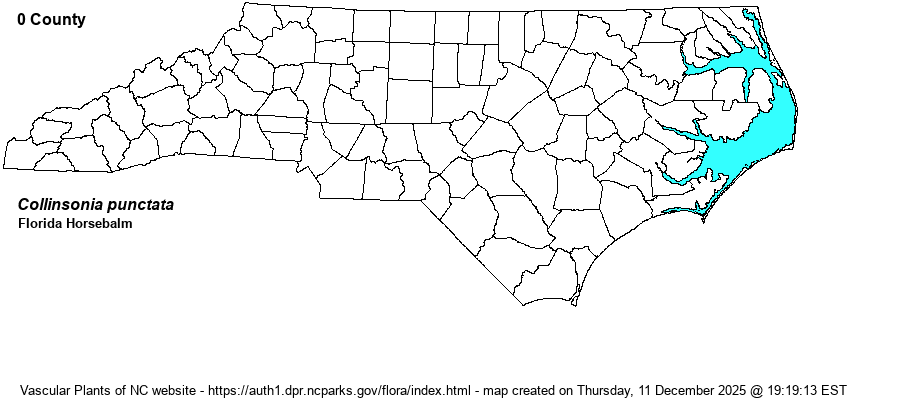| Author | Elliott | |
| Distribution | Plants originally determined as Collinsonia punctata were discovered in NC in September 2024, in Anson County by Becky Dill and Bruce Sorrie. However, additional research has shown that the Anson plants are actually C. canadensis that have paler than usual corollas and tubes, corollas at the large end of C. canadensis, and sepals tapered to sharp tips (vs. blunt in C. punctata).
Ranges on the Coastal Plain from southern SC to northern FL, west to southeastern LA. To date, The Anson County population in NC is the only one in the Piedmont, and that just barely. | |
| Abundance | Anson plants occur scattered along a creek for at least 200 yards; at least 60 plants. In late 2024, the NCNHP placed this species on the Watch List with a State Rank of S1. However, based on recent research of the NC specimen, Sorrie recommends a rank of SRF (Reported Falsely). | |
| Habitat | Mesic steep forested slopes of a Piedmont creek, with brownish mafic rocks nearby. Mixed hardwoods-Loblolly Pine. Calamintha georgiana and Eurybia mirabilis occur nearby. Over its range, occurs in "Rich woods" (Weakley 2024a), but in the Coastal Plain. | |
| Phenology | On 12 September Anson plants varied from late bud stage to full flower to corollas dropping. Weakley (2024a) gives flowering range from late August - mid-October, and fruiting in September-October. | |
| Identification | Collinsonia punctata is robust, generally 1.5-3 feet tall. Leaves are ovate to broadly ovate, very similar to those of C. canadensis; lower leaves with long petioles, upper leaves with reduced petioles, and uppermost leaves very small and generally sessile. Leaf margins each have up to 21 (or more) teeth. From canadensis it is best told by longer calyx and longer corolla--see measurements in FSUS online. In addition, the fringed lip is longer and showier, and the small corolla lobes are wholly yellow-green, lacking red-brown lines as in canadensis (see images at FSUS online). At a distance the inflorescence appears whitish, not dull yellow as in canadensis. Some lip petals had purplish streaking. | |
| Taxonomic Comments | Although named by Stephen Elliott in the early 1800s, C. punctata has been mostly ignored since, or has been treated as a variety of canadensis. However, Peirson et al. (2006) reinstated it as a full species, and Weakley et al. (2024a) follow suit.
| |
| Other Common Name(s) | None? | |
| State Rank | S1 [SRF] | |
| Global Rank | G3? | |
| State Status | W7 | |
| US Status | | |
| USACE-agcp | | |
| USACE-emp | | |

